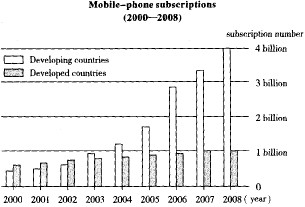which of the following does NOT belong to products that help create people's habits?
-
Part A
Directions: Write a composition/letter of no less than 100 words on the following information. (10 points)
You have just come back from the U. S. as a member of a Sino-American cultural exchange program. Write a letter to your American colleague to
1) express your thanks for his/her warm reception;
2) welcome him/her to visit China in due course.
You should write about 100 words on ANSWER SHEET 2.
Do not sign your own name at the end of the letter. Use " Zhang Wei" instead.
Do not write your address. (10 points)
-
Part B
Directions: Write an essay of 160-200 words based on the following information. (20 points)
In this section, you are asked to write an essay based on the following chart. In your writing, you should 1) interpret the chart and 2 ) give your comments. You should write at least 150 words.
Write your essay on ANSWER SHEET 2. (15 points)

-
(47)
-
(48)
-
Part C
Directions: Read the following text carefully and then translate the underlined segments into Chinese. (10 points)
"Sustainability" has become a popular word these days, but to Ted Ning, the concept will always have personal meaning. Having endured a painful period of unsustainability in his own life made it clear to him that sustainability-oriented values must be expressed through everyday action and choice.
Ning recalls spending a confusing year in the late 1990s selling insurance. He'd been through the dot-com boom and burst and, desperate for a job, signed on with a Boulder agency.
It didn't go well. "It was a really bad move because that's not my passion, " says Ning, whose dilemma about the job translated, predictably, into a lack of sales. "I was miserable. I had so much anxiety that I would wake up in the middle of the night and stare at the ceiling. I had no money and needed the job. Everyone said, 'Just wait, you'll turn the corner, give it some time.
(46)
-
The role that weather plays in formation flight has not yet been clearly defined.
- A.True
- B.False
-
It has been documented that during World War II , America's armed forces once tried formation flight to save fuel.
- A.True
- B.False
-
Formation flight is more comfortable because passengers can not see the other planes.
- A.True
- B.False
-
The upwash experience may save propelling energy as well as reducing resistance.
- A.True
- B.False
-
Part B
Copying Birds May Save Aircraft Fuel
Both Boeing and Airbus have trumpeted the efficiency of their newest aircraft, the 787 and A350 respectively. Their clever designs and lightweight composites certainly make a difference. But a group of researchers at Stanford University, led by Ilan Kroo, has suggested that airlines could take a more naturalistic approach to cutting jet-fuel use, and it would not require them to buy new aircraft.
The answer, says Dr Kroo, lies with birds. Since 1914, scientists have known that birds flying in formation—a V-shape—expend less energy. The air flowing over a bird's wings curls upwards behind the wingtips, a phenomenon known as upwash. Other birds flying in the upwash experience reduced drag, and spend less energy propelling themselves. Peter Lissaman, an aeronautics expert who was formerly at Caltech and the University of Southern California, has suggested that a formation of 25 birds might enjoy a range increase of 71 % .
When applied to aircraft, the principles are not substantially different. Dr Kroo and his team modelled what would happen if three passenger jets departing from Los Angeles, San Francisco and Las Vegas were to assemble over Utah, assume an inverted V-formation, occasionally change places so all could have a turn in the most favourable positions, and proceed to London. They found that the aircraft consumed as much as 15% less fuel (coupled with a reduction in carbon-dioxide output). Nitrogen-oxide emissions during the cruising portions of the flight fell by around a quarter.
There are, of course, knots to be worked out. One consideration is safety, or at least the perception of it. Would passengers feel comfortable travelling in companion? Dr Kroo points out that the aircraft could be separated by several nautical miles, and would not be in the intimate groupings favoured by display teams like the Red Arrows. A passenger peering out of the window might not even see the other planes. Whether the separation distances involved would satisfy air-traffic-control regulations is another matter, although a working group at the International Civil Aviation Organisation has included the possibility of formation flying in a blueprint for new operational guidelines.
It remains to be seen how weather conditions affect the air flows that make formation flight more efficient. In zones of increased turbulence, the planes' wakes will decay more quickly and the effect will diminish. Dr Kroo says this is one of the areas his team will investigate further. It might also be hard for airlines to co-ordinate the departure times and destinations of passenger aircraft in a way that would allow them to gain from formation flight. Cargo aircraft, in contrast, might be easier to reschedule, as might routine military flights.
- As it happens, America's armed forces are on the case already. Earlier this year the country's Defence Advanced Research Projects Agency announced plans to pay Boeing to investigate formation flight, thought the programme has yet to begin. There are repor
- Findings of the Stanford University researchers will promote the sales of new Boeing and Airbus aircraft.
- A.True
- B.False
2005年初级经济师考试《旅游经济专
初级旅游经济师试题及答案一
初级旅游经济师试题及答案二
2005年初级经济师考试《邮电经济专
初级经济师试题及答案1(邮电经济)
初级经济师试题及答案1(保险经济)
初级经济师试题及答案2(邮电经济)
初级经济师试题及答案2(保险经济)
初级经济师试题及答案3(保险经济)
2014年经济师初级考试真题《建筑经
